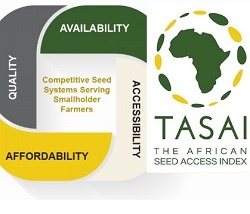The African Seed Access Index : TASAI : improved access to seeds in Sub-Saharan Africa
15/11/2017


Timely availability of improved seeds at affordable prices is critical to increased productivity by smallholder farmers in Africa.
The African Seed Access Index (TASAI) is a tool that appraises the structure and economic performance of formal seed sectors, thus defining success for seed systems based on its ability to deliver the following outcomes for farmers: Availability, Accessibility, Affordability, and Quality.
|
Improved seeds can deliver state of the art technology to farmers including higher yields, disease and pest resistance, climate change adaptation, and improved nutrition. Over the last two decades, formal seed systems in Africa have been gradually liberalized resulting in increased participation of private seed enterprises (multinationals, regional and domestic companies). |
To monitore the development and competitiveness of national seed sectors in Africa, in 2016 and 2017, TASAI research was conducted in 13 countries - Democratic Republic of Congo, Ethiopia, Ghana, Kenya, Madagascar, Malawi, Mozambique, Senegal, South Africa, Tanzania, Uganda, Zambia, and Zimbabwe [Read: Policy briefs summarizing each country research study].
The central objective of TASAI is to encourage African governments and development agencies to create and maintain enabling environments that will accelerate the development of local private sector-led seed systems serving smallholder farmers.
The intended outcome of TASAI is improved access to locally adapted, affordable, and high-quality seed of appropriate varieties by smallholder farmers in Sub-Saharan Africa.
For the top four grain and legume crops in each country, TASAI tracks 20 indicators in five categories:
|
1. Research and Development: Number of active breeders Number of varieties released in last 3 years Availability of foundation seed Average age of varieties sold Percent of varieties with climate-smart features |
2. Industry Competitiveness: Number of active crop seed companies Time it takes to import seed from neighboring countries Market share of top 4 companies Market share of current or past government parastatal |
3. Seed Policy and Regulations: Length of variety release process Status of seed policy framework Quality of regulatory system Adequacy of seed inspectors Efforts to stamp out fake seed Use of smart subsidies |
|
4. Institutional Support: Availability of extension services for smallholder farmers Quality of national seed trade association |
5. Service to Smallholder Farmers: Concentration of rural agro-dealer network Availability of seed in small packages Seed-to-grain price ratios at planting time |
|
Data on all the 20 indicators across the 13 countries, are presented in the TASAI Data Appendix.
TASAI is going to be widely used by practitioners in the public sector, private sector, and development aid agencies to both inform and compel change.
Source: TASAI portal
For more information on TASAI, please contact Dr. Ed Mabaya ([email protected]) or Mainza Mugoya ([email protected]).
Related content:
- FAO's role in seeds
- The Access to Seeds Index measures and compares the efforts of the world’s leading seed companies to enhance the productivity of smallholder farmers (Access to Seeds Index presentation)
- Seedmap.org : an online portal on Seeds, Biodiversity and Food
- Open Source Seed Initiative : Fair and Open Access to plant genetic resources worldwide
- UN agencies provide seeds, tools and food to break hunger cycle in CAR
